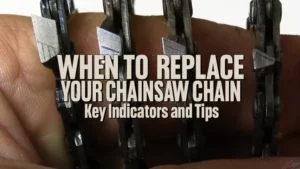How To Use STIHL 2 in 1 Chainsaw Sharpener
- April 24, 2024
- 0 comment
Maintaining the sharpness of your chainsaw’s chain is crucial for its efficiency and safety. The STIHL 2 in 1 Chainsaw Sharpener offers a streamlined solution that simplifies the sharpening process. This tool is specially designed for STIHL chainsaw chains, combining two sharpening processes into one efficient step. This guide will provide detailed instructions on how to use the STIHL 2 in 1 Chainsaw Sharpener to keep your chainsaw operating at peak performance.
Understanding the STIHL 2 in 1 Chainsaw Sharpener
The STIHL 2 in 1 Chainsaw Sharpener is innovative in that it sharpens both the teeth and depth gauges of the chain simultaneously. Here’s what makes it stand out:
- Dual Files: Equipped with a round file for sharpening the teeth and a flat file for adjusting the depth gauges.
- Fixed Angles: Ensures consistent sharpening angles, which is crucial for effective cutting and safety.
- Efficiency: Reduces the time needed for maintenance by handling two tasks at once.

Before you start sharpening with the STIHL sharpener, make sure your chainsaw is securely mounted and the chain is both tight and clean. This prevents any slippage or inaccuracies during sharpening. Determine the type of chain your saw uses to select the appropriate file size and angle settings recommended for your specific chain model. This preparatory step is crucial to ensure that the sharpening process is both efficient and effective, maintaining your chainsaw in optimal cutting condition.
Step-by-Step Guide to Using the STIHL 2 in 1 Sharpener
- Identify the Starting Tooth: Before you begin, identify the leading tooth’s direction as indicated in the sharpener’s instructions. This will guide you on where to start the sharpening process on your chain.
- Position the Sharpener: Carefully place the sharpener on the chain. Make sure the round file is positioned on a tooth while the flat file lies on the raker just in front of that tooth. This alignment is crucial for the sharpener to function correctly.
- Check Alignment: Align the sharpener by ensuring that the marks on the tool match the chain’s required angle, typically 30 degrees. Proper alignment is essential for effective sharpening and to maintain the integrity of the chainsaw’s teeth and rakers.
- Sharpening Motion: Execute the sharpening motion by pushing the file through the tooth away from you in a smooth, single motion; avoid pulling it back through. This helps maintain the sharpener’s effectiveness and prevents wear on the files.
- Continue Along the Chain: After sharpening one tooth, move to the next tooth facing the same direction and repeat the process. Once all the teeth facing one direction are sharpened, switch the orientation of either the chainsaw or the tool to start sharpening the teeth on the opposite side.
- Consistency is Key: For the best results, make sure each tooth is filed the same number of strokes. This ensures an even cutting surface across the chain, which helps in smooth cutting and prolongs the life of your chainsaw.
Take a peek at the video below to catch up quickly!
After you’ve sharpened your chainsaw chain using the STIHL 2 in 1 Sharpener, it’s crucial to inspect the chain. Look for uniform sharpness across all teeth and make any necessary adjustments. A good practice is to test the chainsaw on a piece of wood to ensure it cuts cleanly and straight. If you notice the saw is cutting unevenly or veering to one side, some teeth may still be duller than others, and further adjustments will be necessary.
Maintenance Tips
- Regular Maintenance: Sharpen your chainsaw regularly based on usage, especially after cutting dirty or sandy wood which can dull the chain faster.
- Replace Files as Needed: The files on the STIHL 2 in 1 Sharpener will wear out over time and should be replaced to maintain optimal sharpening efficiency.
- Clean After Use: Keep the sharpener clean and free of wood dust and debris to ensure it works correctly every time.
Troubleshooting Section
Adding a troubleshooting section can greatly enhance the usefulness of your article by helping readers address common problems they might encounter while using the STIHL 2 in 1 Chainsaw Sharpener. Here are some typical issues and their solutions:
- Uneven Sharpening: If the chain is not being sharpened evenly, it could be due to improper placement of the file in the guide or uneven pressure during the sharpening strokes.
- Solution: Ensure the file is properly seated in the guide slots. Apply consistent pressure and count the number of strokes per tooth to maintain uniformity.
- File Slipping: The file might slip if not properly secured, leading to inadequate sharpening.
- Solution: Check that the file is tightly fixed within the sharpener. Replace the file if it is worn out to prevent it from slipping.
- Difficulty in Setting the Correct Angle: Misalignment can result in poor sharpening results.
- Solution: Use the angle guides marked on the sharpener more conscientiously. Ensure the sharpener is aligned with the chain’s angle markings before starting.
- Raker Adjustment Issues: Incorrect raker height can affect the cutting efficiency.
- Solution: After several sharpening sessions, check the raker height with a depth gauge. Adjust if necessary to ensure it’s not too high, which can make the saw’s bite too shallow.
- Sharpener Wear and Tear: Over time, the sharpener might show signs of wear, affecting its performance.
- Solution: Regularly inspect your sharpener for any wear or damage. Replace the files as needed to ensure it continues to function effectively.
Conclusion
The STIHL 2 in 1 Chainsaw Sharpener is a valuable tool for any chainsaw user, from casual gardeners to professional landscapers. By following these detailed instructions, you can ensure your chainsaw remains sharp and efficient, reducing the physical effort needed during cutting tasks and prolonging the lifespan of your chainsaw’s chain. Regular maintenance using such effective tools not only enhances performance but also significantly contributes to the safe operation of your chainsaw.
FAQs
- How often should I sharpen my chainsaw using the STIHL 2 in 1 Sharpener?
It’s recommended to sharpen your chainsaw whenever you notice signs of dulling. Regular maintenance, especially after heavy or dirty work, ensures optimal performance. - Can the STIHL 2 in 1 Sharpener be used on all types of chainsaws?
The sharpener is designed for STIHL chainsaws, but it’s essential to select the correct file size and angle for your specific chainsaw model and chain type. - What makes the STIHL 2 in 1 Chainsaw Sharpener different from other sharpeners?
This sharpener uniquely allows you to sharpen both the teeth and the depth gauges of the chain at the same time, ensuring a consistent angle and depth, which is crucial for effective cutting and safety. - How do I know if the chain is sharp enough after using the sharpener?
A well-sharpened chain will have a uniform, bright appearance on the edges of the cutters. Dark spots may indicate areas that need more filing. - What are the safety precautions I should take while using the STIHL 2 in 1 Sharpener?
Always wear protective gloves and ensure the chainsaw is securely fixed and the chain is clean and tight before you start sharpening. - Can I replace the files on the STIHL 2 in 1 Sharpener?
Yes, the files can wear out over time and should be replaced to maintain optimal sharpening efficiency. Always use high-quality files for replacements. - What angle should the chain be sharpened at with the STIHL 2 in 1 Sharpener?
The sharpener is preset to maintain a 30-degree angle, which is the standard angle for most chainsaw teeth. - How do I maintain the sharpener for longevity?
Keep the sharpener clean and free of wood dust and debris. Regular cleaning helps maintain its functionality and accuracy. - Where can I purchase the STIHL 2 in 1 Chainsaw Sharpener?
It is available at authorized STIHL dealers, and you can also find it online through various retailers.
We hope this guide enhances your confidence and efficiency in maintaining your chainsaw with the STIHL 2 in 1 Sharpener. Have you tried using this tool yet, or do you have any tips for fellow chainsaw enthusiasts? Share your experiences and any questions in the comments below. Let’s help each other make the most out of our chainsaw maintenance!

David Murray
Forestry AuthorI'm David Murry, a forestry equipment specialist with a focus on chainsaw operation. With over 13 years of experience, I've honed my skills in operating and maintaining a wide range of machinery, from chainsaws to log splitters. My passion for the outdoors and commitment to sustainable forestry drive my work, which emphasizes safety, efficiency, and staying updated with industry advancements. Additionally, I'm dedicated to sharing my expertise and promoting environmental awareness within the forestry community.













Leave your comment